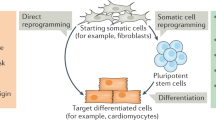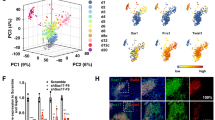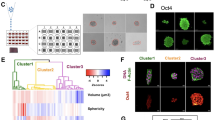Abstract
Recent advances have demonstrated the power of small molecules in promoting cellular reprogramming. Yet, the full potential of such chemicals in cell fate manipulation and the underlying mechanisms require further characterization. Through functional screening assays, we find that mouse embryonic fibroblast cells can be induced to trans-differentiate into a wide range of somatic lineages simultaneously by treatment with a combination of four chemicals. Genomic analysis of the process indicates activation of multi-lineage modules and relaxation of epigenetic silencing programs. In addition, we identify Sox2 as an important regulator within the induced network. Single cell analysis uncovers a novel priming state that enables transition from fibroblast cells to diverse somatic lineages. Finally, we demonstrate that modification of the culture system enables directional trans-differentiation towards myocytic, glial or adipocytic lineages. Our study describes a cell fate control system that may be harnessed for regenerative medicine.
Similar content being viewed by others
Log in or create a free account to read this content
Gain free access to this article, as well as selected content from this journal and more on nature.com
or
Accession codes
References
Takahashi K, Yamanaka S . Induction of pluripotent stem cells from mouse embryonic and adult fibroblast cultures by defined factors. Cell 2006; 126:663–676.
Wernig M, Meissner A, Foreman R, et al. In vitro reprogramming of fibroblasts into a pluripotent ES-cell-like state. Nature 2007; 448:318–324.
Takahashi K, Tanabe K, Ohnuki M, et al. Induction of pluripotent stem cells from adult human fibroblasts by defined factors. Cell 2007; 131:861–872.
Yu J, Vodyanik MA, Smuga-Otto K, et al. Induced pluripotent stem cell lines derived from human somatic cells. Science 2007; 318:1917–1920.
Vierbuchen T, Ostermeier A, Pang ZP, Kokubu Y, Sudhof TC, Wernig M . Direct conversion of fibroblasts to functional neurons by defined factors. Nature 2010; 463:1035–1041.
Szabo E, Rampalli S, Risueno RM, et al. Direct conversion of human fibroblasts to multilineage blood progenitors. Nature 2010; 468:521–526.
Ieda M, Fu JD, Delgado-Olguin P, et al. Direct reprogramming of fibroblasts into functional cardiomyocytes by defined factors. Cell 2010; 142:375–386.
Caiazzo M, Dell'Anno MT, Dvoretskova E, et al. Direct generation of functional dopaminergic neurons from mouse and human fibroblasts. Nature 2011; 476:224–227.
Han DW, Tapia N, Hermann A, et al. Direct reprogramming of fibroblasts into neural stem cells by defined factors. Cell Stem Cell 2012; 10:465–472.
Pereira CF, Chang B, Qiu J, et al. Induction of a hemogenic program in mouse fibroblasts. Cell Stem Cell 2013; 13:205–218.
Huang P, He Z, Ji S, et al. Induction of functional hepatocyte-like cells from mouse fibroblasts by defined factors. Nature 2011; 475:386–389.
Polo JM, Anderssen E, Walsh RM, et al. A molecular roadmap of reprogramming somatic cells into iPS cells. Cell 2012; 151:1617–1632.
Mikkelsen TS, Hanna J, Zhang X, et al. Dissecting direct reprogramming through integrative genomic analysis. Nature 2008; 454:49–55.
Lin T, Ambasudhan R, Yuan X, et al. A chemical platform for improved induction of human iPSCs. Nat Methods 2009; 6:805–808.
Li W, Wei W, Zhu S, et al. Generation of rat and human induced pluripotent stem cells by combining genetic reprogramming and chemical inhibitors. Cell Stem Cell 2009; 4:16–19.
Li Y, Zhang Q, Yin X, et al. Generation of iPSCs from mouse fibroblasts with a single gene, Oct4, and small molecules. Cell Res 2011; 21:196–204.
Huangfu D, Maehr R, Guo W, et al. Induction of pluripotent stem cells by defined factors is greatly improved by small-molecule compounds. Nat Biotechnol 2008; 26:795–797.
Feng B, Ng JH, Heng JC, Ng HH . Molecules that promote or enhance reprogramming of somatic cells to induced pluripotent stem cells. Cell Stem Cell 2009; 4:301–312.
Zhu S, Rezvani M, Harbell J, et al. Mouse liver repopulation with hepatocytes generated from human fibroblasts. Nature 2014; 508:93–97.
Hou P, Li Y, Zhang X, et al. Pluripotent stem cells induced from mouse somatic cells by small-molecule compounds. Science 2013; 341:651–654.
Zhao Y, Zhao T, Guan J, et al. A XEN-like state bridges somatic cells to pluripotency during chemical reprogramming. Cell 2015; 163:1678–1691.
Cheng L, Hu W, Qiu B, et al. Generation of neural progenitor cells by chemical cocktails and hypoxia. Cell Res 2014; 24:665–679.
Hu W, Qiu B, Guan W, et al. Direct conversion of normal and Alzheimer's disease human fibroblasts into neuronal cells by small molecules. Cell Stem Cell 2015; 17:204–212.
Li X, Zuo X, Jing J, et al. Small-molecule-driven direct reprogramming of mouse fibroblasts into functional neurons. Cell Stem Cell 2015; 17:195–203.
Zhang M, Lin YH, Sun YJ, et al. Pharmacological reprogramming of fibroblasts into neural stem cells by signaling-directed transcriptional activation. Cell Stem Cell 2016; 18:653–667.
Fu Y, Huang C, Xu X, et al. Direct reprogramming of mouse fibroblasts into cardiomyocytes with chemical cocktails. Cell Res 2015; 25:1013–1024.
Cao N, Huang Y, Zheng J, et al. Conversion of human fibroblasts into functional cardiomyocytes by small molecules. Science 2016; 352:1216–1220.
Wang Y, Qin J, Wang S, et al. Conversion of human gastric epithelial cells to multipotent endodermal progenitors using defined small molecules. Cell Stem Cell 2016; 19:449–461.
Hescheler J, Fleischmann BK, Lentini S, et al. Embryonic stem cells: a model to study structural and functional properties in cardiomyogenesis. Cardiovasc Res 1997; 36:149–162.
Zeller R, Bloch KD, Williams BS, Arceci RJ, Seidman CE . Localized expression of the atrial natriuretic factor gene during cardiac embryogenesis. Genes Dev 1987; 1:693–698.
Guo G, Huss M, Tong GQ, et al. Resolution of cell fate decisions revealed by single-cell gene expression analysis from zygote to blastocyst. Dev Cell 2010; 18:675–685.
Guo G, Luc S, Marco E, et al. Mapping cellular hierarchy by single-cell analysis of the cell surface repertoire. Cell Stem Cell 2013; 13:492–505.
Hao J, Daleo MA, Murphy CK, et al. Dorsomorphin, a selective small molecule inhibitor of BMP signaling, promotes cardiomyogenesis in embryonic stem cells. PLoS One 2008; 3:e2904.
Hudson J, Titmarsh D, Hidalgo A, Wolvetang E, Cooper-White J . Primitive cardiac cells from human embryonic stem cells. Stem Cells Dev 2012; 21:1513–1523.
Acknowledgements
We thank L Yan, Z Zhong, Y Wang, X Tian, M Nguyen, HE Benjamin, E Macro, Z Shao, M Jiang, L Sun for help on experiments. We thank EpigenDx for DNA methylation analysis and RiboBio for ChIP-seq analysis. We thank Y Zhou, J Ji, W Cai, J Chen, Z Li for insightful discussions on the project. This work was supported by funding from Fundamental Research Funds for the Central Universities (GG), 1000 Youth Talent Plan (GG) and Harvard Stem Cell Institute Pilot Grant (SHO). This work was supported by Zhejiang University Stem Cell Institute. Patent applications have been filed related to the chemical reprogramming method reported in this paper.
Author information
Authors and Affiliations
Corresponding authors
Additional information
( Supplementary information is linked to the online version of the paper on the Cell Research website.)
Supplementary information
Supplementary information, Table S1
Small molecule combinations activate lineage specific regulators in the mouse embryonic fibroblast (MEF) cells. (XLSX 15 kb)
Supplementary information, Table S2
Phenotypic data from screened chemicals or chemical combinations. (XLSX 37 kb)
Supplementary information, Table S3
List of antibodies used for molecular characterization of lineage specific cell types. (XLSX 9 kb)
Supplementary information, Table S4
Microarray data for 6TCF and SGCF treatment time course. (XLSX 4560 kb)
Supplementary information, Table S5
Analysis of differentially expressed genes during iMT process. (XLSX 816 kb)
Supplementary information, Table S6
MACS peak files from H3K4me3 or H3K27me3 ChIP-seq experiments for 6TCF treated or control MEF cells. (XLSX 2317 kb)
Supplementary information, Table S7
Annotation of peaks from H3K4me3 or H3K27me3 ChIP-seq experiments for 6TCF treated or control MEF cells. (XLSX 5526 kb)
Supplementary information, Table S8
Single cell qPCR data during iMT process as well as used qPCR primer. (XLSX 283 kb)
Supplementary information, Movie S1
Spontaneous contraction of trans-differentiated cardiac myocytes from 6TCF treated MEF. (MP4 2936 kb)
Supplementary information, Movie S2
Spontaneous contraction of trans-differentiated cardiac myocytes from SGF treated MEF. (MP4 6810 kb)
Supplementary information, Movie S3
Spontaneous Ca2+ waves observed in trans-differentiated cardiac myocytes from 6TCF treated MEF. (MP4 4312 kb)
Supplementary information, Figure S1
Immunocytochemistry identifies trans-differentiated cells from MEF and TTF cells. (PDF 1132 kb)
Supplementary information, Figure S2
Analysis with differentially expressed genes during iMT process reveals involvement of several key pathways. (PDF 1662 kb)
Supplementary information, Figure S3
iMT process is associated with changes in chromatin structure. (PDF 250 kb)
Supplementary information, Figure S4
A unique gene expression module marks the iMT priming state before cell fate decision. (PDF 128 kb)
Supplementary information, Figure S5
Modification of the iMT chemical combinations enables efficient lineage specific trans-differentiation. (PDF 1125 kb)
Rights and permissions
About this article
Cite this article
Han, X., Yu, H., Huang, D. et al. A molecular roadmap for induced multi-lineage trans-differentiation of fibroblasts by chemical combinations. Cell Res 27, 386–401 (2017). https://doi.org/10.1038/cr.2017.17
Received:
Revised:
Accepted:
Published:
Issue date:
DOI: https://doi.org/10.1038/cr.2017.17
Keywords
This article is cited by
-
MYC promotes fibroblast osteogenesis by regulating ALP and BMP2 to participate in ectopic ossification of ankylosing spondylitis
Arthritis Research & Therapy (2023)
-
Reprogramming of fibroblasts into expandable cardiovascular progenitor cells via small molecules in xeno-free conditions
Nature Biomedical Engineering (2022)
-
Chemicals orchestrate reprogramming with hierarchical activation of master transcription factors primed by endogenous Sox17 activation
Communications Biology (2020)
-
Small Molecules that Promote Self-Renewal of Stem Cells and Somatic Cell Reprogramming
Stem Cell Reviews and Reports (2020)
-
Small molecules for reprogramming and transdifferentiation
Cellular and Molecular Life Sciences (2017)



